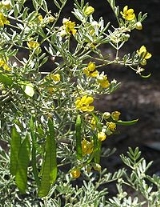
Senna artemisioides
Encyclopedia
- "Blunt-leaved Senna" (and spelling variants) redirects here. This name is also used for Senna obtusifoliaSenna obtusifoliaSenna obtusifolia is a legume in the genus Senna, sometimes separated in the monotypic genus Diallobus. It grows wild in North, Central, and South America, Asia, Africa, and Oceania, and is considered a particularly serious weed in many places...
, a large shrub common in warm humid regions.
Senna artemisioides is a flowering plant
Flowering plant
The flowering plants , also known as Angiospermae or Magnoliophyta, are the most diverse group of land plants. Angiosperms are seed-producing plants like the gymnosperms and can be distinguished from the gymnosperms by a series of synapomorphies...
in the family
Family (biology)
In biological classification, family is* a taxonomic rank. Other well-known ranks are life, domain, kingdom, phylum, class, order, genus, and species, with family fitting between order and genus. As for the other well-known ranks, there is the option of an immediately lower rank, indicated by the...
Fabaceae
Fabaceae
The Fabaceae or Leguminosae, commonly known as the legume, pea, or bean family, is a large and economically important family of flowering plants. The group is the third largest land plant family, behind only the Orchidaceae and Asteraceae, with 730 genera and over 19,400 species...
. It is commonly known as Silver Cassia or Feathery Cassia - although "cassia" generally refers to the largest-growing Cassiinae. Some of its distinct subspecies
Subspecies
Subspecies in biological classification, is either a taxonomic rank subordinate to species, ora taxonomic unit in that rank . A subspecies cannot be recognized in isolation: a species will either be recognized as having no subspecies at all or two or more, never just one...
also have common names of their own. This plant is endemic to Australia
Australia
Australia , officially the Commonwealth of Australia, is a country in the Southern Hemisphere comprising the mainland of the Australian continent, the island of Tasmania, and numerous smaller islands in the Indian and Pacific Oceans. It is the world's sixth-largest country by total area...
, where it is found in all mainland states and territories, except for Victoria
Victoria (Australia)
Victoria is the second most populous state in Australia. Geographically the smallest mainland state, Victoria is bordered by New South Wales, South Australia, and Tasmania on Boundary Islet to the north, west and south respectively....
.
This is a shrub that grows up to 3 metres in height. It has pinnate
Pinnate
Pinnate is a term used to describe feather-like or multi-divided features arising from both sides of a common axis in plant or animal structures, and comes from the Latin word pinna meaning "feather", "wing", or "fin". A similar term is pectinate, which refers to a comb-like arrangement of parts...
leaves with between 1 and 8 pairs of leaflets. It produces an abundance of yellow flowers in winter and spring which are about 1.5 cm in diameter, followed by 2 to 7 cm long flat green pods which age to dark brown.
The species adapts to a wide range of climatic conditions, although it is susceptible to frost, particularly when young. It prefers dry, well drained sites with full sun. As an ornamental plant
Ornamental plant
Ornamental plants are plants that are grown for decorative purposes in gardens and landscape design projects, as house plants, for cut flowers and specimen display...
, it is propagated readily from seed, which should first be soaked in boiling water.
Taxonomy and systematics
The species was first described in 1825 by Charles Gaudichaud-BeaupréCharles Gaudichaud-Beaupré
Charles Gaudichaud-Beaupré was a French botanist.He was born in Angoulême, the son of J-J. Gaudichaud and Rose Gaudichaud. He studied pharmacology at Cognac and Angoulême. He also studied chemistry and herbology.His greatest claim to fame was serving as botanist on a circumglobal expedition from...
based on work by Augustin Pyramus de Candolle and placed in Cassia
Cassia (genus)
Cassia is a genus of Fabaceae in the subfamily Caesalpinioideae. Commonly called cassias, "cassia" is also the English name of Cinnamomum aromaticum in the Lauraceae , and some other species of Cinnamomum...
, but nowadays it has been moved to Senna
Senna (genus)
Senna , the sennas, is a large genus of flowering plants in the family Fabaceae, subfamily Caesalpinioideae. This diverse genus is native throughout the tropics, with a small number of species reaching into temperate regions. The number of species is usually estimated to be about 260, but some...
. However, for a long time this plant was erroneously known as Cassia eremophila which is a true species of Cassia called Desert Cassia, described by Julius Rudolph Theodor Vogel
Julius Rudolph Theodor Vogel
Julius Rudolph Theodor Vogel was a botanist. His author abbreviation is Vogel.-References:...
.
A large number of formerly independent species are provisionally considered subspecies
Subspecies
Subspecies in biological classification, is either a taxonomic rank subordinate to species, ora taxonomic unit in that rank . A subspecies cannot be recognized in isolation: a species will either be recognized as having no subspecies at all or two or more, never just one...
of S. artemisioides:
- ssp. alicia Randell
- ssp. artemisioides
- ssp. filifolia Randell
- ssp. helmsii (Symon) Randell – Blunt-leaved Cassia
- ssp. oligophylla (F.Muell.) Randell – Blunt-leaved Cassia
- ssp. petiolaris Randell Woody Cassia
- ssp. quadrifolia Randell
- ssp. sturtii (R.Br.) Randell – Sturt's Cassia
- ssp. zygophylla (Benth.) Randell
Some hybridogenic subspecies have also been named:
- nothosubsp. × artemisioides
- ssp. × coriacea (Benth.) Randell
- nothosubsp. × coriacea (Benth.) Randell
- nothosubsp. × sturtii (R.Br.) Randell
In addition, there are apparently at least 2 undescribed taxa:
- Senna artemisioides "James Range (P.L.Latz 18528)"
- Senna artemisioides "Kuyunba (B.Pitts 113)"
Altogether, S. artemisioides might be best considered a form taxon
Form taxon
Form classification is the classification of organisms based on their morphology, which does not necessarily reflect their biological relationships...
whose phylogenetic diversity is still largely unresolved.

